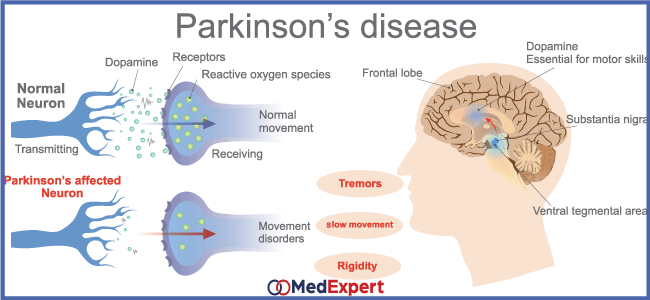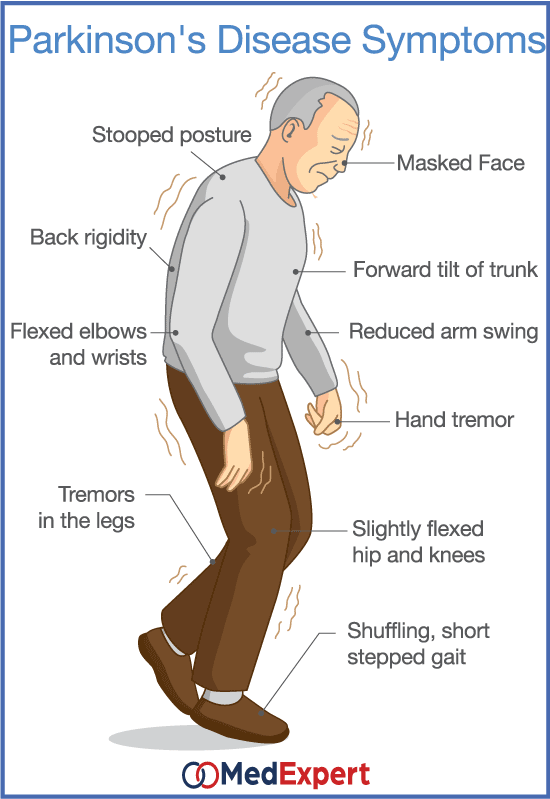Parkinson’s Disease
It occurs when there is gradual degeneration of nerve cells in the portion of the midbrain that controls body movements. Some of the first signs are likely to be barely noticeable. It may include a feeling of weakness or stiffness in 1 limb or a fine trembling may be experienced in one hand when at rest. Eventually, the tremors worsen and spread. Muscles become stiffer, movements slow down and balance and coordination deteriorate.

In the early stages, your face may bear little or no expression. Your arms may not swing when you walk and your speech may become soft or slurred. Depression, cognitive issues, and other mental or emotional problems are common as the disease progresses.
Who’s at risk?
Most of the time, Parkinson’s disease affects older people. It usually begins between the ages of 50 and 65. It strikes about 1% of the population in that age group. This disease is slightly more common in men than in women. However, it can also occur in younger adults.
Even though the disease can’t be cured, medication can be used to treat the symptoms and decrease the disability. In occasional cases, surgery may be suggested to regulate certain regions of your brain and improve the symptoms.
SYMPTOMS OF PARKINSON’S DISEASE
Symptoms and signs may vary from person to person. Early signs may be mild and likely go unnoticed. The often start on 1 side of the body and normally remain worse on that side even after symptoms start to affect both sides. Signs and symptoms may include:
- Tremor: Normally starts in a limb; often the hand or fingers. A back-and-forth rubbing of your thumb and forefinger may be experienced (pill-rolling tremor). One characteristic of the disease is a hand tremor when it is relaxed.
- Slowed movement (bradykinesia): The disease may reduce your ability to move and slow your movement over time. This makes simple tasks difficult and time-consuming. Your steps may become shorter when walking or you may find it difficult to get out of a chair. You may also drag your feet as you try to walk
- Rigid muscles: Muscle stiffness may occur in any part of your body. This can limit your range of motion and cause you pain
- Impaired posture and balance: Posture may become stooped or experience balancing problems
- Loss of automatic movements: A decreased ability to perform unconscious movements. This includes blinking, smiling or swinging your arms when you walk
- Speech changes: May speak softly, quickly, slur or hesitate before talking. Your speech may become more monotonous
- Writing changes: May experience difficulty writing and the words may appear small

TREATMENT OPTIONS AVAILABLE FOR PARKINSON’S DISEASE
There is no known treatment that’s able to stop or reverse Parkinson’s disease. However, there are many treatments that can relieve your symptoms and improve your quality of life.
Factors such as age, work status, family and living situation affect decisions about when to start treatment, the type of treatment and when to make changes in treatment. As the disease progresses, regular changes in treatment may be required to balance quality-of-life issues, side effects of treatment and treatment costs.
You’ll have to meet members of your health care team regularly (every 3 to 6 months or as directed) for treatment adjustments.
Treatments include:
- Medicines: Drugs such as Levodopa and Dopamine agonists are used to relieve symptoms and is the most common treatment for Parkinson’s disease.
- Home treatment: Getting regular exercise and eating a healthy diet can be done at home to relieve symptoms.
- Surgery: For instance, deep brain stimulation (DBS) may be considered as an option when medicine is unable to control symptoms or when it causes severe or disabling side effects.
- Speech therapy: Breathing and speech exercises may be used to help overcome the speech problems and monotonous voice that develops in advanced Parkinson’s disease.
- Physical therapy: Your therapist may help you improve your walking. This will help reduce your risk of falling.
- Occupational therapy: Your therapists may help you to learn new ways to do things for yourself so that you can stay independent longer time.
- Treatment for mental problems: When you begin to have problems with memory, problem solving, learning and other mental functions. This is known as dementia and it can prevent you from doing daily activities. Medicine will be used to help treat dementia.
Experiencing depression is common in people with Parkinson’s disease. It is important to recognize and deal with depression. There are medicine available that can help the symptoms of depression in people with Parkinson’s.
DIAGNOSING PARKINSON’S DISEASE
- Consult with the doctor & neurological examination: The diagnosis of Parkinson’s disease is based on your medical history and a thorough neurological exam. Your sense of smell may also be assessed.
- Medicine: In certain cases, medicine for Parkinson’s disease will be prescribed to be tried. If the medicine relieves your symptoms, it may help with the diagnosis.
- Blood tests: As there are no lab tests that can diagnose Parkinson’s, your doctor may conduct certain tests to check if you have another condition with similar symptoms. Blood tests may be conducted to test for abnormal thyroid hormone levels or liver damage.
- Imaging tests: An imaging test (CT scan or MRI scan) may conducted to check for signs of a stroke or brain tumor. Another type of imaging test, called PET is sometimes used as it may detect low levels of dopamine in the brain which is a key feature of Parkinson’s. However, PET scanning isn’t commonly used to evaluate Parkinson’s as it’s very expensive and unavailable in many hospitals. Besides, it’s only used experimentally.


